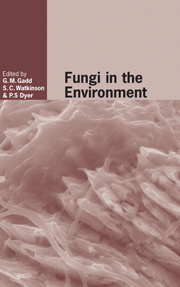Book contents
- Frontmatter
- Contents
- List of contributors
- Preface
- I Imaging and modelling of fungi in the environment
- II Functional ecology of saprotrophic fungi
- III Mutualistic interactions in the environment
- IV Pathogenic interactions in the environment
- V Environmental population genetics of fungi
- VI Molecular ecology of fungi in the environment
- 17 Fungi in the hidden environment: the gut of beetles
- 18 A saltmarsh decomposition system and its ascomycetous laccase genes
- Index
- References
17 - Fungi in the hidden environment: the gut of beetles
from VI - Molecular ecology of fungi in the environment
Published online by Cambridge University Press: 03 November 2009
- Frontmatter
- Contents
- List of contributors
- Preface
- I Imaging and modelling of fungi in the environment
- II Functional ecology of saprotrophic fungi
- III Mutualistic interactions in the environment
- IV Pathogenic interactions in the environment
- V Environmental population genetics of fungi
- VI Molecular ecology of fungi in the environment
- 17 Fungi in the hidden environment: the gut of beetles
- 18 A saltmarsh decomposition system and its ascomycetous laccase genes
- Index
- References
Summary
Introduction
Over the past century the recognition of the presence of endosymbionts in a variety of arthropods has become well established (Buchner, 1965). Intense interest in the rickettsial endosymbionts, widespread among insects (van Meer et al., 1999), led to the discovery that they may induce sterility of the host, and increased rates of speciation have been attributed to their presence (Shoemaker et al., 1999). Bacteria also have long been known for their nutritional contributions to insects, but more recently indigenous gut bacteria have been recognized for their ability to prevent colonization of non-indigenous microbes. In fact the insect gut is considered a ‘hot spot’ of bacterial gene exchange and bacterial adaptation (Dillon & Dillon, 2004). Thus, important attributes that affect speciation, habitat utilization, and survival are provided by prokaryotic symbionts. By contrast, although there were a number of early reports of fungal endosymbionts of insects, fewer of them were substantiated after the original reports (Buchner, 1965). More recent work, however, indicates that insect–yeast interactions abound in nature, although the exact nature of many of the interactions is less well understood (Suh & Blackwell, 2005; Vega & Dowd, 2005).
Yeasts and yeast-like fungi from the guts of a small group of planthoppers (Homoptera) and beetles in three families (Coleoptera: Anobiidae, Cerambycidae and Scolytidae) have been studied most extensively. These fungi have a yeast growth form with single cells and asexual reproduction by budding, the hallmark of the ‘yeast habit’, although many yeasts actually have filamentous growth as well.
- Type
- Chapter
- Information
- Fungi in the Environment , pp. 357 - 370Publisher: Cambridge University PressPrint publication year: 2007
References
- 1
- Cited by



